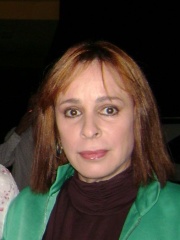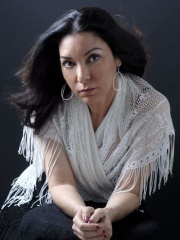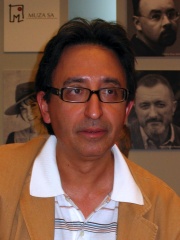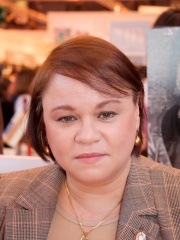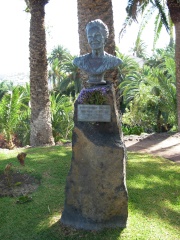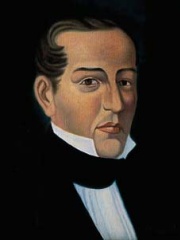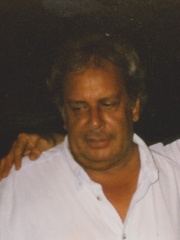

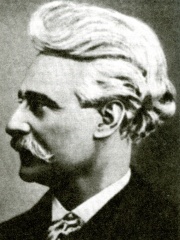

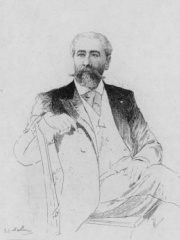
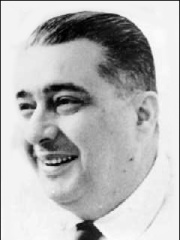
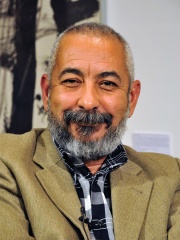

The Most Famous
WRITERS from Cuba
This page contains a list of the greatest Cuban Writers. The pantheon dataset contains 7,302 Writers, 18 of which were born in Cuba. This makes Cuba the birth place of the 56th most number of Writers behind Bosnia and Herzegovina, and Nigeria.
Top 10
The following people are considered by Pantheon to be the top 10 most legendary Cuban Writers of all time. This list of famous Cuban Writers is sorted by HPI (Historical Popularity Index), a metric that aggregates information on a biography's online popularity. Visit the rankings page to view the entire list of Cuban Writers.

1. Italo Calvino (1923 - 1985)
With an HPI of 75.31, Italo Calvino is the most famous Cuban Writer. His biography has been translated into 68 different languages on wikipedia.
Italo Calvino (, also US: ; Italian: [ˈiːtalo kalˈviːno]; 15 October 1923 – 19 September 1985) was an Italian novelist and short story writer. His best-known works include the Our Ancestors trilogy (1952–1959), the Cosmicomics collection of short stories (1965), and the novels Invisible Cities (1972) and If on a winter's night a traveler (1979). Admired in Britain, Australia and the United States, Calvino was the most translated contemporary Italian writer at the time of his death. He is buried in the garden cemetery of Castiglione della Pescaia in Tuscany.

2. José Martí (1853 - 1895)
With an HPI of 73.05, José Martí is the 2nd most famous Cuban Writer. His biography has been translated into 74 different languages.
José Julián Martí Pérez (Spanish: [xoˈse maɾˈti]; 28 January 1853 – 19 May 1895) was a Cuban nationalist, poet, philosopher, essayist, journalist, translator, professor, and publisher, who is considered a Cuban national hero because of his role in the liberation of his country from Spain. He was also an important figure in Latin American literature. He was a political activist and is considered an important philosopher and political theorist. Through his writings and political activity, he became a symbol of Cuba's bid for independence from the Spanish Empire in the 19th century and is referred to as the "Apostle of Cuban Independence". From adolescence on, he dedicated his life to the promotion of liberty, political independence for Cuba, and intellectual independence for all Spanish Americans; his death was used as a cry for Cuban independence from Spain by both the Cuban revolutionaries and those Cubans previously reluctant to start a revolt. Born in Havana, Spanish Empire, Martí began his political activism at an early age. He traveled extensively in Spain, Latin America, and the United States, raising awareness and support for the cause of Cuban independence. His unification of the Cuban émigré community, particularly in Florida, was crucial to the success of the Cuban War of Independence against Spain. He was a key figure in the planning and execution of this war, as well as the designer of the Cuban Revolutionary Party and its ideology. He died in military action during the Battle of Dos Ríos on 19 May 1895. Martí is considered one of the great turn-of-the-century Latin American intellectuals. His written works include a series of poems, essays, letters, lectures, a novel, and a children's magazine. He wrote for numerous Latin American and American newspapers; he also founded a number of newspapers. One of those newspapers, Patria, was an important instrument in his campaign for Cuban independence. After his death, many of his verses from the book Versos Sencillos (Simple Verses) were adapted to the patriotic song "Guantanamera", which has become a prominent representative song of Cuba. The concepts of freedom, liberty and democracy are prominent themes in all of his works, which were influential on Nicaraguan poet Rubén Darío and Chilean poet Gabriela Mistral. Following the 1959 Cuban Revolution, Martí's ideology became a major driving force in Cuban politics. He is also regarded as Cuba's "martyr".

3. Paul Lafargue (1842 - 1911)
With an HPI of 71.68, Paul Lafargue is the 3rd most famous Cuban Writer. His biography has been translated into 40 different languages.
Paul Lafargue (; French: [lafaʁg]; 15 January 1842 – 25 November 1911) was a Cuban-born French political writer, economist, journalist, literary critic, and activist. His best known work is The Right to Be Lazy. Born in Cuba to French and Creole parents, Lafargue spent most of his life in France, with periods in England and Spain. He was Karl Marx's son-in-law, having married his second daughter, Laura. At the age of 69, he and 66-year-old Laura died together in a suicide pact. Lafargue was the subject of a famous quotation by Marx. Soon before Marx died in 1883, he wrote a letter to Lafargue and the French Workers' Party organizer Jules Guesde, both of whom already claimed to represent "Marxist" principles. Marx accused them of "revolutionary phrase-mongering" and of denying the value of reformist struggles. This exchange is the source of Marx's remark, reported by Friedrich Engels, "ce qu'il y a de certain c'est que moi, je ne suis pas Marxiste" ("If one thing is certain, I am not a Marxist").

4. Nicolás Guillén (1902 - 1989)
With an HPI of 63.61, Nicolás Guillén is the 4th most famous Cuban Writer. His biography has been translated into 33 different languages.
Nicolás Cristóbal Guillén Batista (10 July 1902 – 16 July 1989) was a Cuban poet, journalist and political activist. He is best remembered as the national poet of Cuba. Born in Camagüey, Cuba, he studied law at the University of Havana, but abandoned a legal career and worked as both a typographer and journalist. His poetry was published in various magazines from the early 1920s; his first collection, Motivos de son (1930) was strongly influenced by his meeting that year with the African-American poet, Langston Hughes. He drew from son music in his poetry. West Indies, Ltd., published in 1934, was Guillén's first collection with political implications. Cuba's dictatorial Gerardo Machado regime was overthrown in 1933, but political repression intensified. After being jailed in 1936, Guillén joined the Communist Party the next year, traveling to Spain for a Congress of Writers and Artists, and covering the Spanish Civil War as a magazine reporter. After returning to Cuba, he stood as a Communist in the local elections of 1940. This caused him to be refused a visa to enter the United States the following year, but he traveled widely during the next decades in South America, China and Europe. In 1953, after being in Chile, he was refused re-entry to Cuba and spent five years in exile. He returned after the successful Cuban revolution of 1959. From 1961, he served more than 30 years as president of the Unión Nacional de Escritores de Cuba, the National Cuban Writers' Union. His awards included the Stalin Peace Prize in 1954, the 1976 International Botev Prize, and in 1983 he was the inaugural winner of Cuba's National Prize for Literature. His great grandson Manuel de Jesús Guillén Esplugas who protested the Cuban regime during the 2021 11th of July protests was murdered in police custody in 2024 during his 6 year sentence at 29 years old.
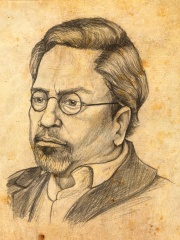
5. Guillermo Cabrera Infante (1929 - 2005)
With an HPI of 62.17, Guillermo Cabrera Infante is the 5th most famous Cuban Writer. His biography has been translated into 31 different languages.
Guillermo Cabrera Infante (Spanish pronunciation: [ɡiˈʝeɾmo kaˈβɾeɾa iɱˈfante]; Gibara, 22 April 1929 – 21 February 2005) was a Cuban novelist, essayist, translator, screenwriter, and critic; in the 1950s he used the pseudonym G. Caín, and used Guillermo Cain for the screenplay of the cult classic film Vanishing Point (1971). A one-time supporter of the politics of Fidel Castro, Cabrera Infante went into exile to London in 1965. He is best known for the novel Tres tristes tigres (literally: "three sad tigers", published in English as Three Trapped Tigers), which has been compared favorably to James Joyce's Ulysses.

6. José-Maria de Heredia (1842 - 1905)
With an HPI of 61.94, José-Maria de Heredia is the 6th most famous Cuban Writer. His biography has been translated into 29 different languages.
José-Maria de Heredia (22 November 1842 – 3 October 1905) was a Cuban-born French Parnassian poet. He was the fifteenth member elected for seat 4 of the Académie française in 1894.

7. José Lezama Lima (1910 - 1976)
With an HPI of 60.03, José Lezama Lima is the 7th most famous Cuban Writer. His biography has been translated into 22 different languages.
José María Andrés Fernando Lezama Lima (December 19, 1910 – August 9, 1976) was a Cuban writer, poet and essayist. He is considered one of the most influential figures in Cuban and Latin American literature. His novel Paradiso is one of the most important works in Spanish and one of the best novels of the 20th Century according to the Spanish newspaper El Mundo. Lezama is a prominent referent of American Neo-Baroque literature. He created a mature poetic system characterized by its lyricism. His work features a wide variety of metaphors, allusions and allegories which he developed in essays such as Analecta del reloj (1953), La expresión americana (1957), Tratados en La Habana (1958) o La cantidad hechizada (1970).

8. Leonardo Padura Fuentes (b. 1955)
With an HPI of 60.00, Leonardo Padura Fuentes is the 8th most famous Cuban Writer. His biography has been translated into 25 different languages.
Leonardo de la Caridad Padura Fuentes (born October 10, 1955) is a Cuban novelist and journalist best known for his Mario Conde detective novels and for El hombe que amaba a los perros (2009). In 2012, Padura was awarded the National Prize for Literature, Cuba's national literary award. In 2015, he was awarded the Premio Principe de Asturias de las Letras of Spain.

9. Pedro Juan Gutiérrez (b. 1950)
With an HPI of 58.59, Pedro Juan Gutiérrez is the 9th most famous Cuban Writer. His biography has been translated into 20 different languages.
Pedro Juan Gutiérrez (born 27 January 1950, in Matanzas, Cuba) is a Cuban novelist. He grew up in Pinar del Río and began to work selling ice cream and newspapers when he was 11 years old. He was a soldier, swimming and kayak instructor, agricultural worker, technician in construction, technical designer, radio speaker, and journalist for 26 years. He is a painter, sculptor and author of several poetry books. He came to Centro Habana, a dilapidated part of the capital, when he was 37 and was astonished by the level of violence but also by the energy of the people who lived there. He is the author of Dirty Havana Trilogy, King of Havana, Tropical Animal (winner of Spain's Alfonso Garcia Ramos Prize in 2000), The Insatiable Spiderman, Dog Meat (winner of Italy's Narrativa Sur del Mundo Prize), Snake's Nest (winner of the Prix des Amériques Insulaires et de la Guyane in 2008), Our GG in Havana, and the short stories of Melancholy of Lions. Dirty Havana Trilogy, Tropical Animal and The Insatiable Spiderman have been translated to English. Since 1994, he has written 10 prose books and five books of poetry. In 2007, he published Corazón Mestizo, a Cuban travel book.
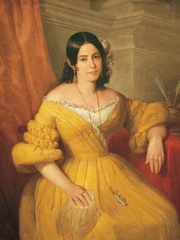
10. Gertrudis Gómez de Avellaneda (1814 - 1873)
With an HPI of 58.40, Gertrudis Gómez de Avellaneda is the 10th most famous Cuban Writer. Her biography has been translated into 22 different languages.
Gertrudis Gómez de Avellaneda y Arteaga (March 23, 1814 – February 1, 1873) was a 19th-century Cuban-born Spanish writer. Born in Puerto Príncipe, now Camagüey, she lived in Cuba until she was 22. Her family moved to Spain in 1836, where she started writing as La Peregrina (The Pilgrim) and lived there until 1859, when she moved back to Cuba with her second husband until his death in 1863, after which she moved back to Spain. She died in Madrid in 1873 from diabetes at the age of 58. She was a prolific writer and wrote 20 plays and numerous poems. Her most famous work, however, is the antislavery novel Sab, published in Madrid in 1841. The eponymous protagonist is a slave who is deeply in love with his mistress Carlota, who is entirely oblivious to his feelings for her.
People
Pantheon has 18 people classified as Cuban writers born between 1803 and 1959. Of these 18, 6 (33.33%) of them are still alive today. The most famous living Cuban writers include Leonardo Padura Fuentes, Pedro Juan Gutiérrez, and Alina Fernández. The most famous deceased Cuban writers include Italo Calvino, José Martí, and Paul Lafargue.
Living Cuban Writers
Go to all RankingsLeonardo Padura Fuentes
1955 - Present
HPI: 60.00
Pedro Juan Gutiérrez
1950 - Present
HPI: 58.59
Alina Fernández
1956 - Present
HPI: 55.93
Daína Chaviano
1957 - Present
HPI: 55.53
José Carlos Somoza
1959 - Present
HPI: 54.34
Zoé Valdés
1959 - Present
HPI: 52.09
Deceased Cuban Writers
Go to all RankingsItalo Calvino
1923 - 1985
HPI: 75.31
José Martí
1853 - 1895
HPI: 73.05
Paul Lafargue
1842 - 1911
HPI: 71.68
Nicolás Guillén
1902 - 1989
HPI: 63.61
Guillermo Cabrera Infante
1929 - 2005
HPI: 62.17
José-Maria de Heredia
1842 - 1905
HPI: 61.94
José Lezama Lima
1910 - 1976
HPI: 60.03
Gertrudis Gómez de Avellaneda
1814 - 1873
HPI: 58.40
Dulce María Loynaz
1902 - 1997
HPI: 58.03
José María Heredia y Heredia
1803 - 1839
HPI: 56.74
Virgilio Piñera
1912 - 1979
HPI: 54.61
Raúl Rivero
1945 - 2021
HPI: 52.87
Overlapping Lives
Which Writers were alive at the same time? This visualization shows the lifespans of the 12 most globally memorable Writers since 1700.

